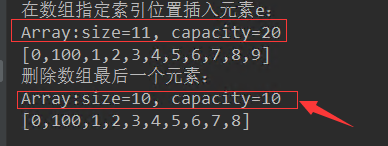1.6封装数组之动态数组实现
前言:在此之前,我们封装的数组属于静态数组,也即数组空间固定长度,对于固定长度的数组当元素超过容量时会报数组空间不足。为了能更好的使用数组,我们来实现一个可以自动扩充容量的数组。
实现思路:
1.当数组容量达到事先定义值时创建一个空间是data数组两倍的newData数组(扩容);
2.把data数组中的元素全部赋值到newData数组中;
3.把data数组重新执行newData数组。
一、定义核心扩容方法
// 数组扩容 private void resize(int newCapacity){ E[] newData = (E[]) new Object[newCapacity]; for (int i = 0; i < size; i++) { newData[i] = data[i]; } data = newData; }
二、改进之前的数组添加元素方法(数组空间不够时自动扩容 --原理空间的2倍)
//在第index个位置插入一个新元素 public void add(int index, E e) { //(1)判断当前需要插入值的位置是否合理,合理则转入(3),否则抛出位置不合法异常 if (index < 0 || index > size) throw new IllegalArgumentException("您选择的位置不合法"); //(2)先判断当前数组容量是否已满,满则进行容量扩充 if (size == data.length) resize(data.length * 2); //将index位置之后的元素往后依次移动一位 for (int i = size - 1; i >= index; i--) { //(3)将index之后的元素依次往后移动一位,然后将新元素插入到index位置 data[i + 1] = data[i]; } data[index] = e; //(4)维护size值 size++; }
三、改进之前的数组删除元素方法(数组空间空闲太大就会缩容(原来空间的1/2))
//从数组中删除index位置的元素,返回删除的元素 public E remove(int index) { //1.判断索引的选择是否合法 if (index < 0 || index > size) throw new IllegalArgumentException("您选择的位置不合法"); //2.先存储需要删除的索引对应的值 E ret = data[index]; //将索引为index之后(index)的元素依次向前移动 for (int i = index + 1; i < size; i++) { //3.执行删除--实质为索引为index之后(index)的元素依次向前移动,将元素覆盖 data[i - 1] = data[i]; } //4.维护size变量 size--; // loitering objects != memory leak 手动释放内存空间 data[size] = null; if (size == data.length / 2) { resize(data.length / 2); } //5.返回被删除的元素 return ret; }
通过以上,我们就可以实现一个动态的数组。
测试一下改进后的代码:
1.测试addLast()
DynamicArray<Integer> arr=new DynamicArray<Integer>(10); for (int i = 0; i < 10; i++) { arr.addLast(i); } System.out.println("添加数组元素:"); System.out.println(arr);
结果为:

2.测试add(int index,E e)方法
arr.add(1, 100); System.out.println("在数组指定索引位置插入元素e:"); System.out.println(arr);
结果:

现在数组已经从刚才定义的容量为10个变为了容量为20个,数组中元素为11个,为此实现了数组扩容。
3.测试removeLast方法
System.out.println("删除数组最后一个元素:");
arr.removeLast();
System.out.println(arr);
结果为:

此时我们可以看出,删除一个元素之后,数组容量又从新变为了10个。
此小节到此为止,若你喜欢,关注我,我们一起加油!
本节所有代码:
1 /** 2 * 3.动态数组 3 * 数组容量可变 4 */ 5 6 7 public class DynamicArray<E> { 8 //使用private 的目的是防止用户从外界修改,造成数据不一致 9 private E[] data; 10 private int size;//数组中元素个数 11 12 //构造函数,传入数组的容量capacity构造Array函数 13 public DynamicArray(int capacity) { 14 data = (E[]) new Object[capacity];//泛型不能直接实例化 15 size = 0; 16 } 17 18 //无参构造函数,默认数组的容量capacity=10 19 public DynamicArray() { 20 this(10); 21 } 22 23 //获取数组中元素个数 24 public int getSize() { 25 return size; 26 } 27 28 //获取数组的容量 29 public int getCapacity() { 30 return data.length; 31 } 32 33 //获取数据是否为空 34 public boolean iEmpty() { 35 return size == 0; 36 } 37 38 //向所有元素后添加元素 39 public void addLast(E e) { 40 add(size, e);//size表示此时的最后一个元素 41 } 42 43 //在所有元素之前添加一个新元素 44 public void addFirst(E e) { 45 add(0, e);//0表示第一个位置 46 } 47 48 //在第index个位置插入一个新元素 49 public void add(int index, E e) { 50 //(1)判断当前需要插入值的位置是否合理,合理则转入(3),否则抛出位置不合法异常 51 if (index < 0 || index > size) 52 throw new IllegalArgumentException("您选择的位置不合法"); 53 54 //(2)先判断当前数组容量是否已满,满则进行容量扩充 55 if (size == data.length) 56 resize(data.length * 2); 57 58 59 //将index位置之后的元素往后依次移动一位 60 for (int i = size - 1; i >= index; i--) { 61 //(3)将index之后的元素依次往后移动一位,然后将新元素插入到index位置 62 data[i + 1] = data[i]; 63 } 64 data[index] = e; 65 //(4)维护size值 66 size++; 67 } 68 69 //获取index索引位置的元素 70 public E get(int index) { 71 //(1)判断当前需要插入值的位置是否合理,合理则转入(2),否则抛出位置不合法异常 72 if (index < 0 || index > size) 73 throw new IllegalArgumentException("您选择的位置不合法"); 74 75 //(2)返回索引index对应的值 76 return data[index]; 77 } 78 79 //获取最后一个元素 80 public E getLast() { 81 return get(size - 1); 82 } 83 84 //获取第一个元素 85 public E getFirst() { 86 return get(0); 87 } 88 89 //修改index索引位置的元素为e 90 void set(int index, E e) { 91 //(1)判断当前需要插入值的位置是否合理,合理则转入(2),否则抛出位置不合法异常 92 if (index < 0 || index > size) 93 throw new IllegalArgumentException("您选择的位置不合法"); 94 95 //(2)修改索引index对应的值 96 data[index] = e; 97 } 98 99 //查找数组中是否包含元素e 100 public boolean contains(E e) { 101 for (int i = 0; i < size; i++) { 102 if (data[i] == e) 103 return true; 104 } 105 return false; 106 } 107 108 //查找数组中元素e所在的索引(只是一个),如果不存在元素e,则返回-1; 109 public int find(E e) { 110 for (int i = 0; i < size; i++) { 111 if (data[i] == e) 112 return i; 113 } 114 return -1; 115 } 116 117 //从数组中删除index位置的元素,返回删除的元素 118 public E remove(int index) { 119 //1.判断索引的选择是否合法 120 if (index < 0 || index > size) 121 throw new IllegalArgumentException("您选择的位置不合法"); 122 123 //2.先存储需要删除的索引对应的值 124 E ret = data[index]; 125 126 //将索引为index之后(index)的元素依次向前移动 127 for (int i = index + 1; i < size; i++) { 128 //3.执行删除--实质为索引为index之后(index)的元素依次向前移动,将元素覆盖 129 data[i - 1] = data[i]; 130 } 131 //4.维护size变量 132 size--; 133 // loitering objects != memory leak 手动释放内存空间 134 data[size] = null; 135 136 //缩容操作 137 if (size == data.length / 2 && data.length != 0) { 138 resize(data.length / 4); 139 } 140 //5.返回被删除的元素 141 return ret; 142 } 143 144 //从数组中删除第一个元素,返回删除的元素 145 public E removeFirst() { 146 return remove(0); 147 } 148 149 //从数组中删除最后一个元素,返回删除的元素 150 public E removeLast() { 151 return remove(size - 1); 152 } 153 154 //从数组中删除元素(只是删除一个) 155 public void removeElement(E e) { 156 int index = find(e); 157 if (index != -1) 158 remove(index); 159 } 160 161 // 数组扩容方法 162 private void resize(int newCapacity) { 163 E[] newData = (E[]) new Object[newCapacity]; 164 for (int i = 0; i < size; i++) { 165 newData[i] = data[i]; 166 } 167 data = newData; 168 } 169 170 @Override 171 public String toString() { 172 StringBuilder res = new StringBuilder(); 173 res.append(String.format("Array:size=%d, capacity=%d\n", size, data.length)); 174 res.append('['); 175 for (int i = 0; i < size; i++) { 176 res.append(data[i]); 177 if (i != size - 1) { 178 res.append(","); 179 } 180 } 181 res.append(']'); 182 return res.toString(); 183 } 184 185 }
测试代码:
1 public class test { 2 public static void main(String[] args) { 3 4 DynamicArray<Integer> arr=new DynamicArray<Integer>(10); 5 for (int i = 0; i < 10; i++) { 6 7 arr.addLast(i); 8 } 9 System.out.println("添加数组元素:"); 10 System.out.println(arr); 11 12 arr.add(1, 100); 13 System.out.println("在数组指定索引位置插入元素e:"); 14 System.out.println(arr); 15 16 System.out.println("删除数组最后一个元素:"); 17 arr.removeLast(); 18 System.out.println(arr); 19 20 } 21 }
As you wish.





